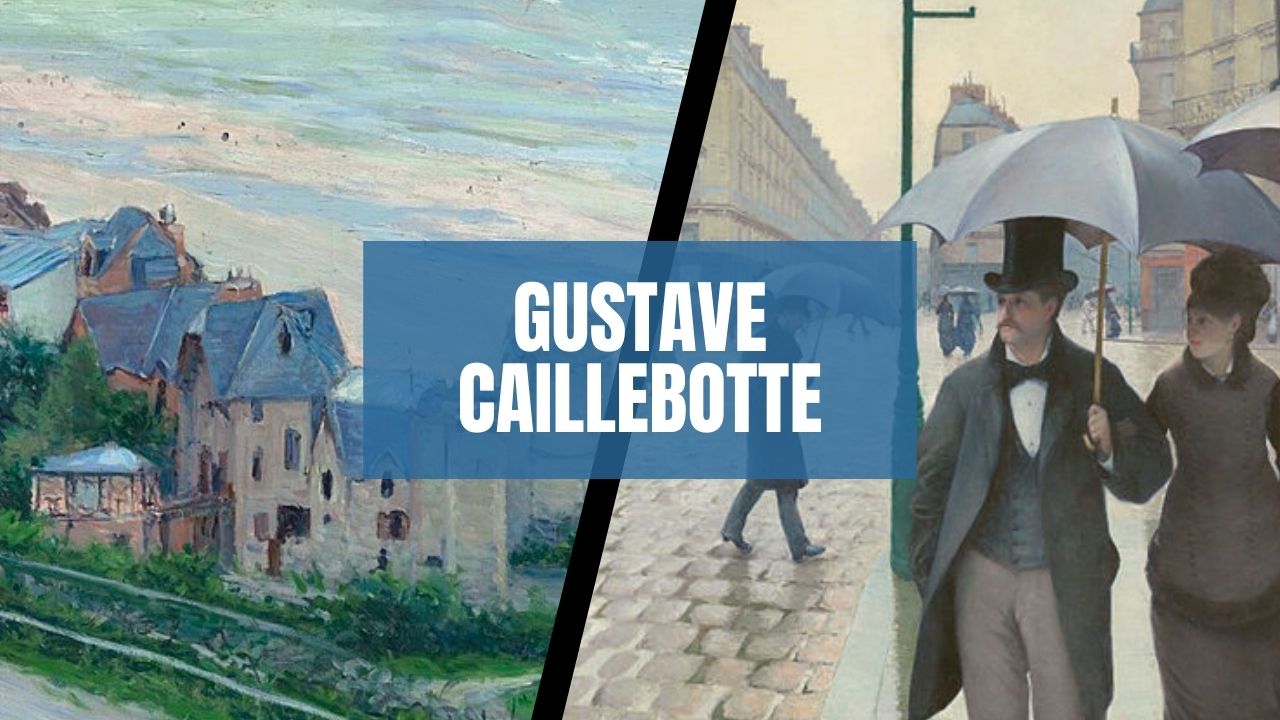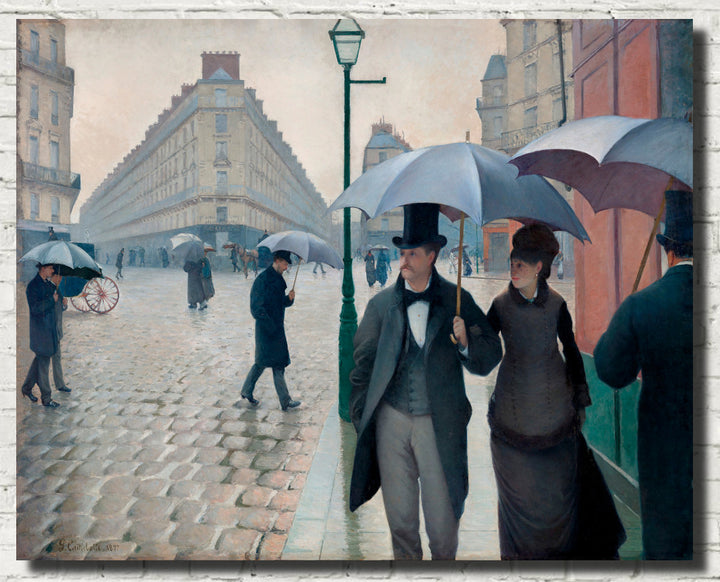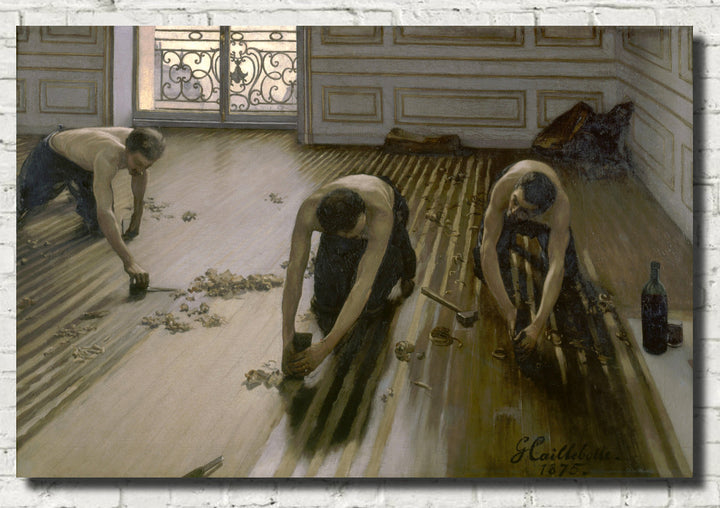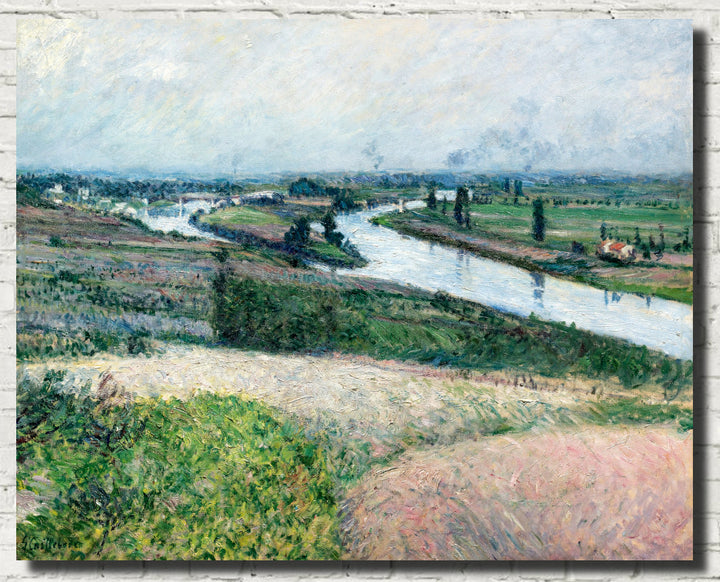Table of Contents:[hide]
Gustave Caillebotte, a name less familiar than some of his Impressionist contemporaries, has left an indelible mark on the art world with his unique style and innovative approach. Born on August 19, 1848, in Paris, France, Caillebotte's life was one of both privilege and artistic passion, which fueled his remarkable journey as a painter.
Early Life and Family Background of Gustave Caillebotte
Gustave Caillebotte was born into a wealthy and prominent family in Paris. His father, Martial Caillebotte, was a successful businessman who dealt in textiles and real estate. This affluence not only provided Gustave with financial security but also afforded him the opportunity to dedicate his life to art without the constraints of financial concerns.
Gustave's family life was marked by a profound tragedy. At the age of seven, he lost his mother, Céleste Daufresne, to cholera. This loss deeply affected him, leaving a lasting emotional scar that would find its expression in his art later in life.
Early Artistic Pursuits
Gustave Caillebotte's interest in art was evident from an early age. He began his formal artistic education at the Lycée Louis-le-Grand, where he showed promise as a painter. His talent was further nurtured by private tutors and his older brother Martial, who shared his artistic enthusiasm. Martial, a more conventional artist, played a significant role in Caillebotte's early development as a painter.
In 1868, at the age of 20, Caillebotte enrolled in the École des Beaux-Arts, the prestigious fine arts school in Paris. The institution's rigorous training and emphasis on traditional academic techniques left a lasting impression on him, and his work would often blend this academic precision with the revolutionary spirit of the Impressionist movement.
Gustave Caillebotte - A Video of his Paintings
The Impressionist Circle and Influence
Caillebotte's life took a pivotal turn when he became involved with the emerging Impressionist movement. He met Edgar Degas, Pierre-Auguste Renoir, and Claude Monet, among others, forming close friendships with many of them. These connections exposed him to the avant-garde ideas of the time and encouraged him to explore new artistic horizons.
The Impressionists were known for their departure from traditional academic painting. They sought to capture fleeting moments of everyday life, often focusing on the effects of light and color on their subjects. Caillebotte, inspired by this innovative approach, started to experiment with his style and subject matter.
Caillebotte's Unique Style
Gustave Caillebotte's art is characterized by a distinctive blend of realism and Impressionism. His early works exhibit a meticulous attention to detail, a testament to his academic training. However, as he delved deeper into Impressionism, his style evolved, reflecting the movement's emphasis on capturing the ephemeral.
One of Caillebotte's most iconic works, "Paris Street; Rainy Day" (1877), exemplifies his unique approach. The painting depicts a Parisian street scene during a rain shower, featuring a wide, modern boulevard and elegantly dressed urbanites. The precision with which Caillebotte rendered the wet cobblestones and the reflections of the buildings in the rain-soaked streets is remarkable.
Yet, what sets this painting apart is its sense of detachment, almost as if Caillebotte is observing the scene from a distance. This perspective, along with the use of strong diagonals and a subdued color palette, gives the work an air of mystery and modernity. It is both a celebration of the city's transformation during the Industrial Revolution and a reflection on the isolation and alienation that could come with urbanization.
Urban Themes and Modernity
Caillebotte's fascination with the changing urban landscape of Paris is a recurring theme in his art. During the late 19th century, Paris underwent a significant transformation, with broad boulevards and modern buildings replacing the narrow, winding streets of the past. This transformation intrigued Caillebotte, and he became known for his paintings that captured the city's evolving character.
In "The Floor Scrapers" (1875), he portrayed three workers meticulously scraping the wooden floor of an apartment. This mundane task, rendered with precision and detail, becomes a symbol of urban labor and progress. Caillebotte's careful attention to the play of light on the floorboards elevates this seemingly simple scene to a work of art that encapsulates the spirit of the era.
Family and Personal Life
Despite his growing reputation as an artist, Caillebotte remained a private individual. His family, particularly his brother Martial, played a significant role in his life. They shared a deep bond, both personally and artistically. Martial often served as a model for Gustave's paintings, and the two collaborated on various artistic endeavors.
Caillebotte's personal life was marked by a certain degree of mystery. He never married and led a discreet lifestyle. Some speculate that his introverted nature and the emotional scars left by his mother's early death contributed to his reclusive tendencies.
Collector and Patron of the Arts
In addition to his career as an artist, Caillebotte had a profound impact as a collector and patron of the arts. He had a discerning eye for art and assembled an impressive collection of works by his fellow Impressionists. His patronage supported struggling artists and contributed to the growth of the Impressionist movement.
Caillebotte's legacy as a collector is perhaps most evident in his bequest to the French government. Upon his death in 1894, he left a significant portion of his collection to the Musée du Luxembourg, now part of the Musée d'Orsay, ensuring that these revolutionary works of art would be preserved and appreciated by future generations.
Later Years and Legacy
As Caillebotte's career progressed, his art continued to evolve. He explored various subjects, including portraits, landscapes, and still life. His works began to display a softer, more lyrical quality, a departure from the detached urban scenes for which he was initially known.
In his later years, Caillebotte turned his attention to gardening and even designed his own garden in Petit Gennevilliers, a suburb of Paris. The garden became a frequent subject of his paintings, reflecting his love for nature and the tranquility it provided.
Gustave Caillebotte passed away on February 21, 1894, at the age of 45, leaving behind a body of work that continues to captivate art enthusiasts and scholars alike. His contributions to the Impressionist movement, both as an artist and a patron, have solidified his place in art history.
Today, Caillebotte's paintings are displayed in renowned museums worldwide, a testament to his enduring influence and the timelessness of his art. His ability to bridge the gap between tradition and innovation, precision and impression, makes him a fascinating figure in the rich tapestry of art history, forever celebrated for his unique vision and indelible mark on the art world.
Gustav Caillebotte FAQ's
1. Who was Gustave Caillebotte, and why is he significant in art history?
- Gustave Caillebotte was a French painter in the late 19th century. He's significant for his unique blend of realism and Impressionism, as well as his contributions to the Impressionist movement both as an artist and patron.
2. What are some of Gustave Caillebotte's most famous paintings?
- Some of his most famous works include "Paris Street; Rainy Day," "The Floor Scrapers," "Boating on the Yerres," and "The Luncheon."
3. What sets Caillebotte apart from other Impressionists?
- Caillebotte's art is distinguished by its meticulous detail combined with Impressionist techniques. He often portrayed urban scenes and modern life with a unique detachment.
4. How did Caillebotte's wealth influence his art career?
- Caillebotte came from a wealthy family, which allowed him to pursue art without financial constraints. This financial freedom gave him the opportunity to explore innovative artistic avenues.
5. What themes did Caillebotte frequently explore in his paintings?
- Caillebotte often depicted urban life in Paris during the 19th century, showcasing the city's transformation during the Industrial Revolution. He also explored themes of isolation, modernity, and labor.
6. What is the significance of "Paris Street; Rainy Day" in Caillebotte's oeuvre?
- "Paris Street; Rainy Day" is considered one of Caillebotte's masterpieces. It captures both the beauty and isolation of urban life, blending precision with Impressionist techniques.
7. Did Caillebotte only paint urban scenes, or did he explore other subjects as well?
- While he is known for urban scenes, Caillebotte also painted landscapes, portraits, and still life. In his later years, he focused on gardening, which became a frequent subject.
8. How did Caillebotte support his fellow Impressionist artists?
- Caillebotte was not only an artist but also a collector and patron of the arts. He supported struggling Impressionist painters by purchasing their works and offering financial assistance.
9. What was Caillebotte's role in preserving Impressionist art for future generations?
- Caillebotte bequeathed a significant part of his art collection to the French government upon his death. This collection now resides in museums like the Musée d'Orsay, preserving Impressionist works for posterity.
10. What is Gustave Caillebotte's lasting legacy in the art world?
- Caillebotte's legacy lies in his unique artistic vision, which bridged traditional techniques with the innovative spirit of Impressionism. He continues to be celebrated for his contributions to art history and the enduring appeal of his works.
Gustave Caillebotte, most famous paintings:
- "Paris Street; Rainy Day" (1877)
- "The Floor Scrapers" (1875)
- "Boating on the Yerres" (1877)
- "The Luncheon" (1876)
- "Portrait of Richard Gallo" (1878)
- "The Orange Trees" (1878)
- "The Pont de l'Europe" (1876)
- "Skiffs" (1884)
- "Plate of peaches" (1881)
- "Man at His Bath" (1876)
- "The Yellow Roses in the Garden at Petit Gennevilliers" (1893)
- "Gardener at His Garden at Petit Gennevilliers" (1893)
- "The Garden at Petit Gennevilliers" (1893)
- "Nude on a Couch" (1873)
- "The Effect of Snow" (1878)
- "Landscape at Yerres" (1875)
- "Interior" (1880)
- "The Park at Yerres" (1877)
- "Dahlias in a Copper Vase" (1883)
- "Young Man at His Window" (1875)
- "Garden Path in the Summer" (1882)
- "Self-Portrait" (1892)
- "Portraits in the Countryside" (1876)
- "Bather, Seen from Behind" (1880)
- "Yerres, Rain" (1875)
- "The Garden in Petit Gennevilliers" (1894)
- "On the Pont de l'Europe" (1876)
- "Rue Halevy, From the 6th Floor" (1878)
- "Chrysanthemums in a Vase" (1893)
- "The Yerres, Effect of Rain" (1875)
- "Portrait of a Man in a Bowler Hat" (1877)
- "Interior, Woman at the Window" (1880)
- "Chrysanthemums" (1893)
- "Rising Road" (1881)
- "The Park Monceau" (1878)
- "The Poplar Alley" (1894)
- "The Basin at Argenteuil" (1880)
- "Portrait of Martial Caillebotte" (1877)
- "Boulevard Haussmann, Snow" (1880)
- "Rue de Paris; Rainy Day" (1877)
- "Rue de Paris; Sunlight Effect" (1877)
- "Interior, Woman Reading" (1880)
- "Red Roofs, Corner of a Village" (1877)
- "Nasturtiums" (1892)
- "Halévy Street, View from the Sixth Floor" (1877)
- "Sunflowers in a Vase" (1892)
- "The Park at Yerres" (1877)
- "The Artist's Garden at Petit Gennevilliers" (1893)
- "The Yerres, Effect of Rain" (1875)
- "The Seine at Argenteuil" (1882)
- "The Seine and the Railroad Bridge at Argenteuil" (1883)
- "Yerres, Effect of Rain" (1875)
- "Portrait of Henri Cordier" (1883)
- "The Bridge at Argenteuil" (1883)
- "Portrait of Madame Martial Caillebotte" (1877)
- "Petit Gennevilliers, the Garden Wall" (1894)
- "Portrait of Gustave Caillebotte, the Artist's Father" (1877)
- "Portrait of a Man in a Top Hat" (1881)
- "Rooftops in the Snow" (1878)
- "Portraits in the Countryside" (1876)
- "The Artist's Garden" (1877)
- "The Pont de l'Europe, Snow Effect" (1876)
- "The Park Monceau" (1878)
- "Chrysanthemums in the Garden at Petit Gennevilliers" (1893)
- "Portrait of a Young Man in a Red Waistcoat" (1881)
- "Argenteuil, the Bridge Under Repair" (1883)
- "Banks of a Canal" (1884)
- "Portrait of a Man Seated at a Desk" (1880)
- "The Seine and the Railroad Bridge at Argenteuil" (1885)
- "The Artist's Father in His Garden at Yerres" (1877)
- "Boulevard Haussmann, Snow" (1880)
- "The Pont de l'Europe, Snow Effect" (1876)
- "A Man at His Window" (1876)
- "The Artist's Father in His Garden" (1877)
- "La Place Saint-Augustin, temps brumeux" (1876)
- "The Bridge at Argenteuil" (1883)
- "Portraits in the Countryside" (1876)
- "The Yerres, Effect of Rain" (1875)
- "Interior, Woman at the Window" (1880)
- "Portrait of Martial Caillebotte" (1877)
- "Rising Road" (1881)
- "The Park Monceau" (1878)
- "Red Roofs, Corner of a Village" (1877)
- "Boulevard Haussmann, Snow" (1880)
- "Rue de Paris; Rainy Day" (1877)
- "Rue de Paris; Sunlight Effect" (1877)
- "Interior, Woman Reading" (1880)
- "Red Roofs, Corner of a Village" (1877)
- "Nasturtiums" (1892)
- "Woman at a Window" (1877)
- "Villas at Trouville"
- "Orchard, Flowering Trees at Petit Genevilliers"




